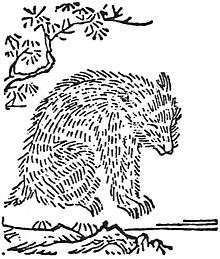Mujina
Mujina (貉) is an old Japanese term primarily referring to the Japanese badger, but traditionally to the Japanese raccoon dog (tanuki), causing confusion.[1][2] Adding to the confusion, it may also refer to the introduced civets, and in some regions badger-like animals or Japanese raccoon dog are also called mami.

In reality
The confusion over the term mujina has led to legal consequences in Japan. In Tochigi Prefecture in 1924, a hunter killed a raccoon dog, which he believed to be called a mujina.[2] He believed badgers were a protected species as they were called tanuki in Tochigi Prefecture. However, the law banning the hunting of tanuki was referring to such raccoon dogs, as a raccoon dog is called tanuki in Tokyo. The Japanese Supreme Court ruled the hunter was legitimately confused (although the reason that he was judged not guilty was on the interpretation of "date of hunt", not the word confusion).[2]
In folklore

In Japanese folklore, like the Kitsune (fox) and the tanuki (typically a Japanese raccoon dog), mujina (which could be raccoon dog or badger) are frequently depicted as yōkai that shapeshift and deceive humans. They are first seen in literature in the Nihon Shoki in the part about Empress Suiko's 35th year (627), where it states, "[I]n two months of spring, there are mujina in the country of Mutsu (春2月、陸奥国に狢有り), they turn into humans and sing songs (人となりて歌う)" demonstrating that, in that era, there was the general idea that mujina shapeshift and deceive humans.[3] In the Shimōsa region, they are called kabukiri-kozō (かぶきり小僧), and they would shapeshift into a kozō (little monk) wearing a strangely short kimono with a kappa-like bobbed head, and frequently appear on roads at night without many people and say, "Drink water, drink tea (水飲め、茶を飲め)."[4] The story in Lafcadio Hearn's kaidan collections called "Mujina"[5] about the witnessing of a faceless ghost (a noppera-bō) is also well-known.
The faceless ghost from Kwaidan
On May 19, 1959, Honolulu Advertiser reporter Bob Krauss reported a sighting of a mujina at the Waialae Drive-In Theatre in Kahala. Krauss reported the witness watched a woman combing her hair in the women's restroom, and when the witness came close enough, the mujina turned, revealing her featureless face.
The witness was reported to have been admitted to the hospital for a nervous breakdown. Noted Hawaiian historian, folklorist, and author Glen Grant, in a 1981 radio interview, dismissed the story as rumor, only to be called by the witness herself, who gave more details on the event, including the previously unreported detail that the mujina in question had red hair.[6] The drive-in no longer exists, having been torn down to make room for Public Storage.
Grant has also reported on a number of other mujina sightings in Hawaii, from ‘Ewa Beach to Hilo.
Other uses
The term can also refer to the following:
- "Mujina", a short story relating to the above legends, found in Lafcadio Hearn's book Kwaidan: Stories and Studies of Strange Things.
- Mujina-no-yu is an onsen facility in Nasu, Tochigi, Japan.
References
- Sato, Ryuzo (1934). "3" [Distinction between tanuki and mujina]. Tanuki-ko 狸考 [Thoughs in tanuki (Japanese raccoon dog)] (in Japanese). Japan. p. 15. doi:10.11501/1076759.
(rough translation)tanuki and mujina are often distinguished but refers to the same animal. ... mami may mean badger
- Tanuki-mujina incident (ja:たぬき・むじな事件) (Japanese Supreme Court 1925-06-09). Text
- 笹間良彦 (1994). 図説・日本未確認生物事典. 柏書房. pp. 120頁. ISBN 978-4-7601-1299-9.
- 小川景 (November 1939). "妖怪其他". 民間伝承. 第5巻 (第2号): 9.
- Monsters You Never Heard Of!: THE MUJINA by Michael D. Winkle. Accessed 3/7/08
- THE FACELESS WOMAN MUJINA. Source: B. Krauss, "Faceless Ghost". Accessed online 03/07/08
- Notes
- de Visser, M. W. (1908). "The Fox and the Badger in Japanese Folklore". Transactions of the Asiatic Society of Japan. 36: 1–159. Retrieved 2006-12-14.
- Casal, U. A. (1959). "The Goblin Fox and Badger and Other Witch Animals of Japan". Folklore Studies. 18: 1–93. doi:10.2307/1177429. JSTOR 1177429.
- Hearn, Lafcadio; Oliver Wendell Holmes (1904). Kwaidan: Stories and Studies of Strange Things. Houghton, Mifflin and company. pp. 77–80.
mujina.
